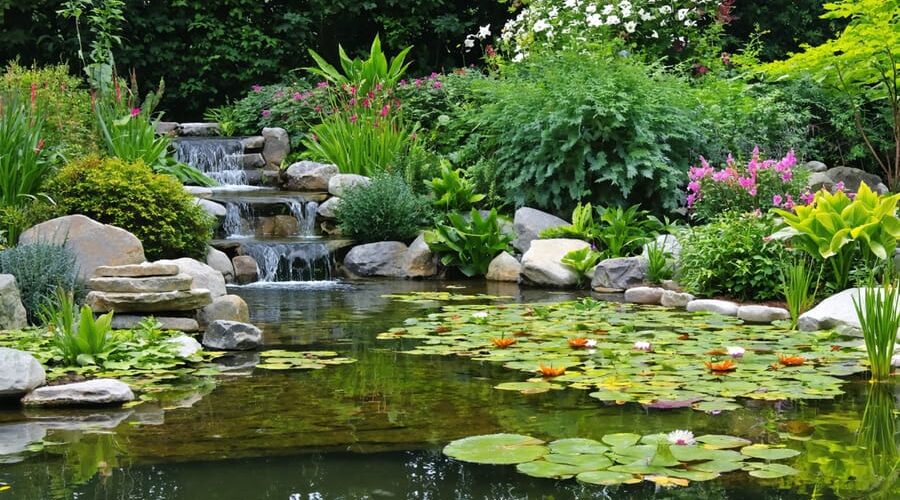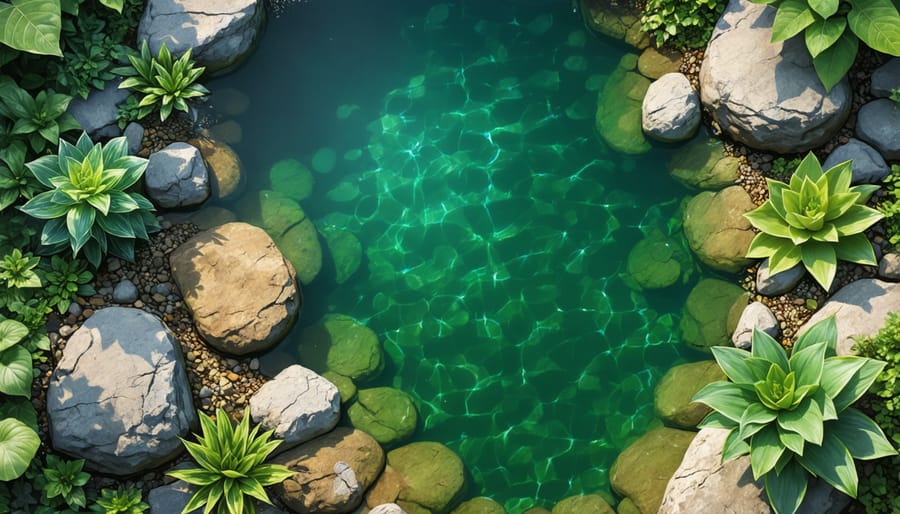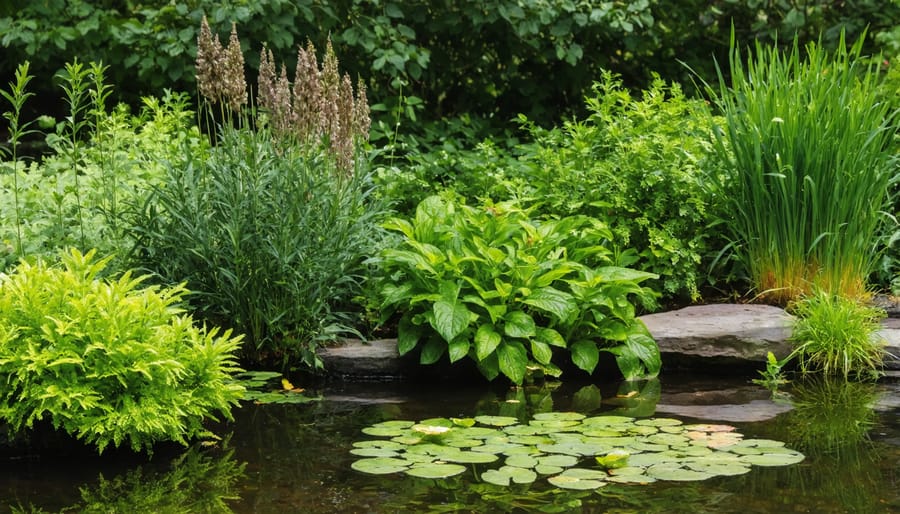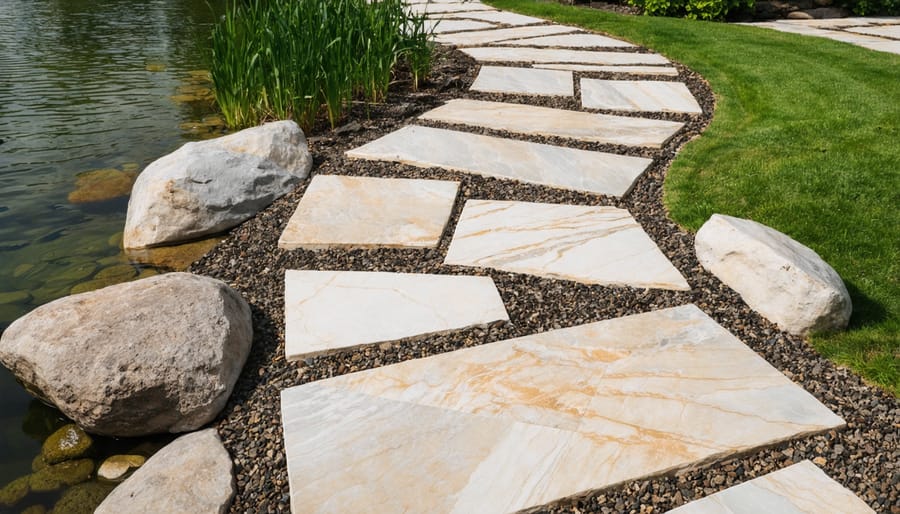
Transform Your Pond’s Edge into a Stunning Natural Paradise
Transform your outdoor space into a living ecosystem by designing a pond that seamlessly blends with its surroundings. From natural stone borders to carefully selected aquatic plants, creating the perfect pond requires thoughtful planning and an eye for detail. Whether you’re dreaming of a serene meditation spot or a vibrant wildlife habitat, exploring various backyard pond ideas can help you craft a water feature that enhances your landscape’s natural beauty.
Start by mapping your pond’s footprint based on available space and sunlight patterns. Consider incorporating multiple depth zones – shallow shelves for marginal plants, medium depths for water lilies, and deeper sections for fish. Layer different textures and materials along the edges, using a combination of rocks, gravel, and native plants to create a natural transition between water and land. This thoughtful approach to pond design not only produces stunning visual results but also supports a thriving aquatic ecosystem that will bring your garden to life.
Planning Your Pond Border Design
Assessing Your Space and Environment
Before diving into your pond design, take time to carefully assess your outdoor space. Start by measuring the available area, noting any slopes, existing vegetation, and utilities like underground pipes or electrical lines. Consider how sunlight moves across your yard throughout the day – most water plants thrive with 6-8 hours of direct sunlight.
Evaluate your soil type by doing a simple drainage test: dig a hole about 12 inches deep, fill it with water, and observe how quickly it drains. This information will help determine if you need additional liner protection or drainage solutions.
Pay attention to natural water flow during rainfall. Your pond should work with, not against, the natural landscape. Look for low-lying areas that might collect water, as these could be ideal pond locations. Also, consider views from different angles – both from your house and garden seating areas.
Don’t forget to check local regulations regarding pond depth and fencing requirements. Understanding these factors early will save you time and potential headaches later in the design process.
Creating a Natural Transition Zone
Creating a seamless transition between your pond and the surrounding landscape is crucial for achieving a natural, harmonious look. The key to successful natural pond landscaping lies in gradually blending the water’s edge with your garden space.
Start by varying the depth around the pond’s perimeter, creating gentle slopes rather than abrupt edges. This mimics natural water bodies and provides different zones for various plant types. Place larger rocks and boulders along the edges, partially submerging some to create a more organic look. Tuck smaller stones and gravel between these larger elements to fill gaps naturally.
Add marginal plants at different heights, starting with underwater varieties and working your way up to taller specimens on the bank. Consider using native plants that naturally occur near water bodies in your area. They’ll not only look more authentic but will also attract local wildlife and require less maintenance.
Remember to include some shallow areas or beach-like zones where wildlife can easily access the water. These transitional spaces will make your pond feel like it’s always been part of the landscape rather than an artificial addition.


Choosing the Right Plants
Marginal Plants
Marginal plants are essential for creating a natural transition between your pond and the surrounding landscape. Through smart plant integration, these shallow-water lovers add color, texture, and vital ecological benefits to your water feature.
Choose plants that thrive in water depths between 0-6 inches for the best results. Popular options include iris, rushes, and marsh marigolds, which create stunning displays while helping to stabilize the pond’s edge. These plants not only look beautiful but also provide natural filtration and create habitats for beneficial wildlife.
When placing marginal plants, arrange them in groups rather than single specimens for a more natural appearance. Start with taller plants at the back and graduate to shorter varieties toward the water. Consider seasonal interest by mixing plants that bloom at different times – imagine purple iris in spring, followed by yellow flag iris in summer, and cardinal flowers bringing vibrant reds in fall.
Remember to plant in aquatic baskets filled with aquatic compost, topped with gravel to prevent soil from clouding the water. This approach makes maintenance easier and helps control aggressive spreaders.
Bog Garden Plants
A bog garden creates a stunning transition between your pond and the surrounding landscape, hosting plants that love consistently moist conditions. Popular choices include the striking Japanese Iris, which produces gorgeous purple blooms, and the dramatic Lobelia cardinalis with its brilliant red flowers that attract hummingbirds. Marsh Marigolds offer cheerful yellow blooms in spring, while Astilbe adds delicate plumes in shades of pink, white, and red.
For architectural interest, consider the tall and graceful Joe-Pye Weed or the distinctive Gunnera with its massive leaves. Ferns like the Royal Fern and Lady Fern thrive in boggy conditions and add a lush, woodland feel. For ground cover, Creeping Jenny creates a carpet of golden-green foliage that trails beautifully over the pond edges.
Don’t forget grasses! Sedges and rushes add vertical interest and movement, while Sweet Flag offers variegated foliage and a pleasant fragrance. For year-round structure, plant Ligularia with its bold leaves and bright yellow flowers. Remember to group plants with similar water needs together, placing those requiring the most moisture closest to the water’s edge.
Transitional Zone Plants
The transitional zone, where water meets land, offers exciting opportunities for creating a natural-looking pond edge. Plants in this area need to tolerate both wet and dry conditions, making them perfect bridge-builders between your pond and garden.
Iris varieties are excellent choices for this zone, with their striking flowers and ability to handle fluctuating water levels. Japanese iris and yellow flag iris are particularly well-suited, adding vertical interest and vibrant colors during blooming seasons.
Rushes and sedges work wonderfully here too. They’re low-maintenance and provide year-round greenery. Consider adding sweet flag (Acorus) for its aromatic foliage, or marsh marigolds for bright spring blooms.
For larger transitional areas, Joe Pye weed and swamp milkweed offer height and attract butterflies. Lobelia cardinalis, with its brilliant red flowers, thrives in these conditions and adds a dramatic splash of color.
Remember to plant in groups rather than single specimens for a more natural look. These plants will help stabilize your pond’s edge while creating a seamless blend between water and land.
Hardscaping Elements
Natural Stone Selection
Selecting the right stones for your pond can make the difference between a natural-looking water feature and an obviously artificial one. Start by choosing rocks that are native to your area – they’ll not only look more authentic but are usually easier to source and transport.
When selecting stones, aim for a mix of sizes. Large boulders create dramatic focal points and help anchor the design, while medium-sized rocks form the backbone of your pond’s structure. Smaller stones and pebbles are perfect for filling gaps and creating natural-looking transitions between larger elements.
Look for rocks with weathered surfaces and interesting textures. Avoid perfectly smooth or uniformly shaped stones as they can appear artificial. Limestone and granite are excellent choices for pond building, but steer clear of rocks that could alter your water chemistry, like those containing metal deposits.
When placing your stones, position the largest boulders first, partially submerging them for a more natural appearance. Create the illusion of age by “planting” some rocks deeper into the ground, as if they’ve always been there. Arrange smaller stones around the larger ones, mimicking natural rock formations you might see in nature.
Remember to leave some spaces between rocks for plants to grow and provide hiding spots for pond life. This creates a more dynamic and lived-in environment that will mature beautifully over time.
Pathways and Access Points
Creating easy access to your pond isn’t just about maintenance – it’s about enjoying your water feature to the fullest. Start by planning a main viewing area where you can relax and appreciate your pond. This spot should offer the best vantage point of key features like waterfalls or focal plants.
Include stepping stones or a gravel path around at least one side of the pond for maintenance access. These pathways should be at least 3 feet wide to accommodate wheelbarrows and equipment. Set stones slightly above ground level to prevent mud splashing during rain, and ensure they’re stable to prevent accidents.
Consider installing a small deck or patio area near the pond’s edge. This creates a perfect spot for sitting and feeding fish, or simply enjoying the peaceful atmosphere. Remember to keep the surface slightly sloped away from the pond to prevent runoff from entering the water.
For safety and convenience, add subtle lighting along pathways. Solar-powered lights work well and don’t require complex wiring. If your pond has different levels, incorporate natural stone steps or wooden platforms to make maintenance easier.
Keep pathways clear of tall plants that might obstruct access, but don’t be afraid to let some low-growing ground cover soften the edges of your walking areas. This creates a more natural look while maintaining functionality.

Maintenance and Care
Seasonal Management
A well-designed pond requires different care approaches throughout the year to maintain its beauty and health. In spring, focus on clearing winter debris, pruning dead foliage, and preparing plants for new growth. Check your pump and filtration system, and follow these water feature maintenance tips to ensure everything runs smoothly.
Summer demands regular maintenance of border plants, including deadheading spent blooms and trimming aggressive growers. Keep an eye on water levels, as evaporation increases during hot weather. Consider adding shade plants or floating vegetation to reduce algae growth and protect fish.
Autumn brings falling leaves – your biggest challenge. Install protective netting early to prevent leaves from sinking and decomposing in the water. Cut back marginal plants and remove tender species before first frost. Remove dying vegetation promptly to prevent nutrient build-up in the water.
Winter maintenance is minimal but crucial. Remove ice build-up to maintain oxygen exchange, but never break ice directly on the pond surface. Protect borderline hardy plants with mulch or move them to sheltered areas. Keep the pond edge clear of snow to maintain visibility of potential hazards.
Remember to adjust fertilization schedules seasonally, reducing applications during dormant periods. Regular monitoring of plant health and water quality throughout the year will help maintain your pond’s natural beauty and ecological balance.
Problem Prevention
Preventing common pond problems starts with smart planning and regular maintenance. One of the biggest challenges is algae growth, which you can minimize by including plenty of aquatic plants that compete with algae for nutrients. Aim for coverage of about 60-70% of your pond’s surface with a mix of floating and submerged plants.
Leaks are another frequent concern. Prevent them by using quality liner material and installing it carefully, avoiding sharp rocks or roots that could puncture it. Create a protective underlayment using sand or specialized pond padding before laying the liner.
Water quality issues often stem from poor filtration or overcrowding. Size your filter system appropriately for your pond’s volume and fish population. A good rule of thumb is to install a filter rated for at least 50% more than your actual pond size.
Predator problems can be devastating to fish populations. Install netting or create deeper areas (at least 2-3 feet) where fish can hide. Strategic placement of rocks and plants around the edges also provides natural shelter.
Bank erosion is preventable by properly compacting soil during construction and using appropriate edge materials. Avoid steep slopes and incorporate plenty of marginal plants to stabilize the soil.
Finally, address potential winter damage by installing a de-icer in cold climates and maintaining proper depth to prevent freezing solid.
Creating a beautiful pond border is an exciting journey that can transform your outdoor space into a stunning water garden paradise. By following the principles and techniques we’ve discussed, you can achieve that seamless integration between your pond and the surrounding landscape that makes it look like nature’s own handiwork.
Remember to start with careful planning, considering both the practical aspects like maintenance access and the aesthetic elements that will make your pond border truly special. Choose your plants thoughtfully, mixing different heights, textures, and bloom times to create year-round interest. Don’t forget to incorporate rocks and other natural materials to establish that crucial transition zone between water and land.
The key to success lies in working with your site’s natural features while maintaining a balance between beauty and functionality. Take your time with the installation process, and don’t be afraid to make adjustments as your pond border develops and matures.
Whether you’re starting from scratch or renovating an existing pond border, the transformation process is incredibly rewarding. Your pond border will not only enhance the visual appeal of your water feature but also create valuable habitats for wildlife and provide endless enjoyment for you and your family.
So grab your gardening tools and let your creativity flow. With patience and dedication, you’ll soon have a stunning pond border that looks like it’s always been part of your landscape.
